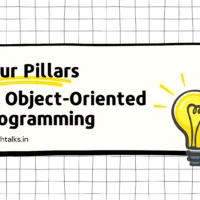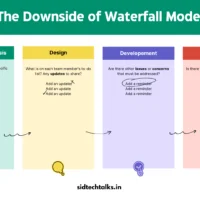Hey everyone, we will learn the essential pillars of object-oriented programming for creating maintainable and reusable code. And how it can help developers to maintain large projects.
Object-oriented programming (OOP) is a programming paradigm that provides a set of rules and principles to help developers write clean and organized code.
In this comprehensive guide, we will explore each pillar in-depth and understand how they contribute to the effectiveness of object-oriented programming.
Introduction to Object-Oriented Programming
Object-oriented programming is a programming paradigm that organizes code around objects, which are instances of classes. It allows developers to model real-world entities and their interactions by encapsulating data and behavior within objects. The fundamental pillars or principles of OOPs are below:
Encapsulation: Controlling Access
Encapsulation is the process of bundling data and methods together within a class and controlling access to them. It allows for better data security and helps prevent unauthorized access and modification of object properties.
Encapsulation also promotes code reusability and maintainability by hiding internal logic. By encapsulating data and methods, developers can ensure that objects are accessed and modified in a controlled manner. This helps prevent unintended side effects and improves code maintainability.
In JavaScript, you can use object literals or constructor functions for encapsulation.
1 2 3 4 5 6 7 8 9 10 11 | const person = { name: "Sid", age: 26, greeting: function() { console.log(`Hello, my name is ${this.name}, and I am ${this.age} years old.`); } }; person.greeting(); // Output: "Hello, my name is Sid, and I am 26 years old." |
In this example, the person object encapsulates the name and age properties along with the greeting method.
Inheritance: Reusing Code
Inheritance is a concept that allows objects to acquire properties and behaviors from parent objects. It promotes code reuse and provides a way to create hierarchical relationships between classes.
In OOPs, inheritance is achieved by creating a subclass that inherits properties and methods from a superclass. The subclass can then add its own unique properties and methods or override inherited ones.
In JavaScript, you can achieve inheritance using prototypes or ES6 classes.
1 2 3 4 5 6 7 8 9 10 11 12 13 14 15 16 17 18 19 20 21 22 23 24 25 26 27 28 29 | class Animal { constructor(name) { this.name = name; } speak() { console.log(`${this.name} makes a sound.`); } } class Dog extends Animal { speak() { console.log(`${this.name} says Woof!`); } } class Cat extends Animal { speak() { console.log(`${this.name} says Meow!`); } } const myDog = new Dog("Jack"); const myCat = new Cat("Evie"); myDog.speak(); // Output: "Jack says Woof!" myCat.speak(); // Output: "Evie says Meow!" |
Polymorphism: Flexibility and Interchangeability
Polymorphism is achieved through method overriding and method overloading.
Method overloading allows to use same method of many forms with different parameters to coexist within a class. Method overriding allows a subclass to provide a different implementation of a method defined in its superclass.
It enables developers to write code that can work with objects of different types without knowing their specific implementations. This promotes code flexibility and extensibility, as new types can be easily added without affecting existing code.
Let’s take an example of method overriding:
1 2 3 4 5 6 7 8 9 10 11 | function animalSpeak(animal) { animal.speak(); } const myDog = new Dog("Jack"); const myCat = new Cat("Evie"); animalSpeak(myDog); // Output: "Jack says Woof!" animalSpeak(myCat); // Output: "Evie says Meow!" |
The animalSpeak function can accept objects of different classes that share a common method ( speak in this case), demonstrating polymorphism in JavaScript.
Abstraction: Hiding Complexity
Abstraction is the process of hiding implementation details and exposing only the essential features of an object.
An example of abstraction in OOP is creating a Vehicle class that has methods like start(), stop(), and accelerate(). The implementation details of these methods can vary for different types of vehicles, but the abstraction allows users of the Vehicle class to interact with it in a consistent manner.
In JavaScript, you can use constructor functions or ES6 classes for abstraction.
1 2 3 4 5 6 7 8 9 10 11 12 13 14 15 16 17 18 19 20 21 22 23 24 25 26 27 28 29 | class Shape { area() { throw new Error("This method should be overridden by subclasses."); } perimeter() { throw new Error("This method should be overridden by subclasses."); } } class Circle extends Shape { constructor(radius) { super(); this.radius = radius; } area() { return Math.PI * this.radius * this.radius; } perimeter() { return 2 * Math.PI * this.radius; } } const myCircle = new Circle(5); console.log(myCircle.area()); // Output: 78.53981633974483 |
Benefits of Object-Oriented Programming
Object-oriented programming offers several benefits over other programming paradigms. Some of the key benefits include:
- Modularity: OOP allows for modular code development, making it easier to understand, test, and maintain.
- Reusability: The use of classes and inheritance promotes code reuse, reducing duplication and improving efficiency.
- Flexibility: Polymorphism provides flexibility and interchangeability of objects, allowing for more adaptable and extensible code.
- Encapsulation: Encapsulation enhances data security and code maintainability by controlling access to object properties and methods.
- Abstraction: Abstraction hides implementation details, allowing developers to focus on the essential aspects of an object’s behavior.
Learn more: What is the Downside of Using the Traditional Waterfall Approach?
Conclusion
So, the four pillars of object-oriented programming – abstraction, encapsulation, inheritance, and polymorphism – provide a solid foundation for creating clean, modular, and reusable code.
By applying these principles, developers can create software that is easier to maintain, extend, and understand. So embrace the four pillars of object-oriented programming and unlock the full potential of your software development projects.
So, that’s all about the OOPs concept. Try these important concepts in your project to make the code more clean, and reusable, and enhance productivity in software development.
I hope you enjoyed the article and if you found this useful, then please share it with your friends and colleagues.
If you have any queries please feel free to post them in the comments section or anything that you wanted to ask through mail contact.
Happy Learning!
Also read,
- Understanding Agile Methodology in Project Management
- Designer vs Frontend vs Backend in Web Development
- What is API and REST APIs? – In easy language


![[12] Helpful Functions in Javascript that You Need to Know](https://sidtechtalks.in/wp-content/uploads/2022/09/12-Helpful-Functions-in-Javascript-that-You-Need-to-Know-520x293.png)






